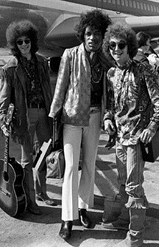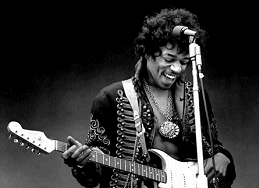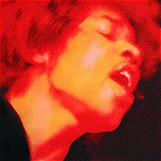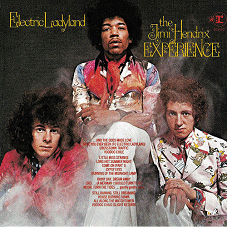Sixties
City presents
a wide-ranging series of
articles on all aspects of the Sixties, penned by the creator of the iconic
60s music paper Mersey
Beat
|
Sixties
City presents
a wide-ranging series of
articles on all aspects of the Sixties, penned by the creator of the iconic
60s music paper Mersey
Beat
|
||||||
|
| The
third album by Jimi Hendrix with his original Experience was a million-seller
that topped the American charts and provided him with his only American
chart-topping single, his version of Bob Dylan’s ‘All Along The Watchtower’
(it reached No.5 in Britain) while ‘Crosstown Traffic’ reached No.37 in
the British charts. Incidentally, as a piece of trivia, ‘All Along the Watchtower’
(from the ‘John Wesley Harding’ album) was the only Bob Dylan cover Jimi
ever recorded and, coincidentally, Dylan’s surname can be found in the title
of the album. The double album has Jimi backed by John 'Mitch' Mitchell on drums and Noel Redding on bass: the members of the Jimi Hendrix Experience. Additional musicians were Al Kooper, Stevie Winwood, Jack Cassidy, Buddy Miles, Chris Wood, Freddie Smith, Mike Finnigan and Larry Faucette. The album, 76 minutes in length, was recorded in New York and London between June 1967 and June 1968 and issued in America on Reprise on 16th October 1968 and in Britain on Track Records on 25th October. Jimi penned most of the original material and Noel Redding composed the track ‘Little Miss Strange’. The live track ‘Voodoo Child’ has Stevie Winwood playing organ and Jack Cassidy of Jefferson Airplane on bass. The tracks were: And All The Gods Made Love; (Have You Ever Been To) Electric Ladyland; Crosstown Traffic; Voodoo Child; Rainy Day, Dream Away; 1983 (A Merman I Should Turn To Be); Moon, Turn The Tide…Gently, Gently Away; Little Miss Strange; Long Hot Summer; Come On; Gypsy Eyes; the Burning Of The Midnight Lamp; Still Raining, Still Dreaming; House Burning Down; All Along The Watchtower; Voodoo Child (Slight Return). There were problems at the recording sessions, which caused producer/manager Chas Chandler to abandon the production and sell his management shares to Mike Jeffrey. Chas produced ‘Crosstown Traffic’, The Burning Of The Midnight Lamp’ and ‘All Along the Watchtower’, but wasn’t prepared to continue after the problems recording ‘Gypsy Eyes’ at the Record Plant in New York. Chas commented, “Drugs didn’t get in the way of shows, and it didn’t get in the way of recording, but I thought it was getting in the way of his brain…mainly acid. It was fu**ing madness”. |
 |
 |
The track
actually took 41 takes and Chas said: “Jimi would turn up at the studio
with a dozen hangers-on who you’ve never seen before in your life. You used
a sort of shorthand conversation in the studio when there’s nobody around
but when there’s an audience around, people get uptight. It changes the
atmosphere in the studio. He wanted me to go over and over songs, some things
he’d got in the first take. I just couldn’t communicate with him. I felt
like an alien.” Eric Burdon was to say, “Would he listen to Chas? No. So
Chas got to the point of like, ‘Oh, I can’t deal with that crazy nigger
any more, it’s too much of a drain on me’ and so the window of opportunity
was there for Mike Jeffrey to walk right in and scoop it all, and I knew
that something dodgy was gonna happen. But I never dreamt it would lead
to his death.” The British sleeve of Electric Ladyland was considered too risqué. Many shops sold the album in brown paper bags! Hendrix himself disliked the cover and said it detracted from the music. The record company was happy with the controversy and publicity. The idea for the cover came from Chris Stamp and David King, art director of Track Records. Stamp sent King and photographer David Montgomery to the Speakeasy club in Margaret Street to get some girls who were offered £5 a head to pose for the sleeve and £10 if they agreed to pose with their knickers off. One of the 19 girls, Reimie Sutcliffe, told the music paper Melody Maker, “It makes us look like a load of old tarts. It’s rotten. Everyone looked great but the picture makes us look old and tired. We were trying to look too sexy, but it didn’t work out.” |
| Montgomery
recalled, “It was actually pretty hairy. We poured a line of petrol about
15 feet across and we lit it. He was standing in front of it – he could
have had his head blown off. The flames go up about 15 feet high.” Jimi
had wanted a photograph by Linda McCartney to grace the cover and, when
the naked ladies image was used, Linda commented, “I think everybody thought
it was his idea. We did get something in the American cover, which had an
open-out cover. All the photographs inside were black and white, which I
took. They showed him as a human being, rather than a freak, you know”.
The cover photograph of the Reprise album was by Karl Ferris. Commenting on the mix for ‘All Along The Watchtower’ Tony Bonglovi, a Record Plant engineer said, “The song had begun on four-track, progressed to 12-track and finally 16-track. In the transfer process, the tape got lost and we ended up doing more than 15 different mixes. Hendrix would stop the tape, pick up his guitar, or the bass, and go back out and start re-overdubbing stuff. Recording these new ideas meant that he would have to erase something. In the weeks prior to the mixing, we had already recorded a number of overdubs, wiping track after track – and I don’t mean once or twice – he would overdub the bass and guitar parts all over, until he was satisfied. He wouldn’t say, ‘I think I hear it a bit differently". |
 |
 |
In May
1968 Chas decided to discontinue working as producer with Jimi, although
he would continue as co-manager. He said. “We didn’t fall out during the
recording of ‘Electric Ladyland’, so much as the sessions seemed to fall
apart out of apathy. In New York, during the recording, I was spending a
lot of time trying to stop the intake of illegal substances. There were
a lot of hangers-on turning up at the studio and any artist in that situation
is inevitably going top start playing to the gallery instead of to the tape
machine”. Jimi said, “Like ‘House Burning Down’ we made the guitar sound like it was on fire. It’s constantly changing dimensions and, up on top, that lead guitar is cutting through everything”. Noel Redding said “It got to the point in New York when I told him he was a stupid cu*t. He depended too much on himself as writer, producer and musician. He was always trying to do it his way. There were times when I used to go to a club between sessions, pull a chick, come back, and he was still tuning his guitar. Oh, hours it took. We should have worked as a team, but it didn’t work”. The ‘Electric Ladyland’ album was released in the States with a different cover than the British one. On the release, Chas was to comment, “When the album came out and I saw that it was ‘produced and directed by Jimi Hendrix’, I was pi**ed off. I was especially surprised to see so much of what I had done was on there, because I know how much more time they spent at the Record Plant after I had walked off the project. In all truth, I had expected to see a much different album.” Jimi penned a note: “We dedicate this album to acoustic and electric woman and man alike, and to the girl at or from or with the button stone, and Arizona, and Bill of some English town in England, and well, EVERYBODY.” Another problem also arose when a studio technician had renamed the album ‘Electric Landlady’. However, a furious Hendrix noticed the mistake before it went any further. Interestingly enough, Kirsty McColl was amused by that title and used it herself on her fourth album, issued in 1991. |
|
Article
|